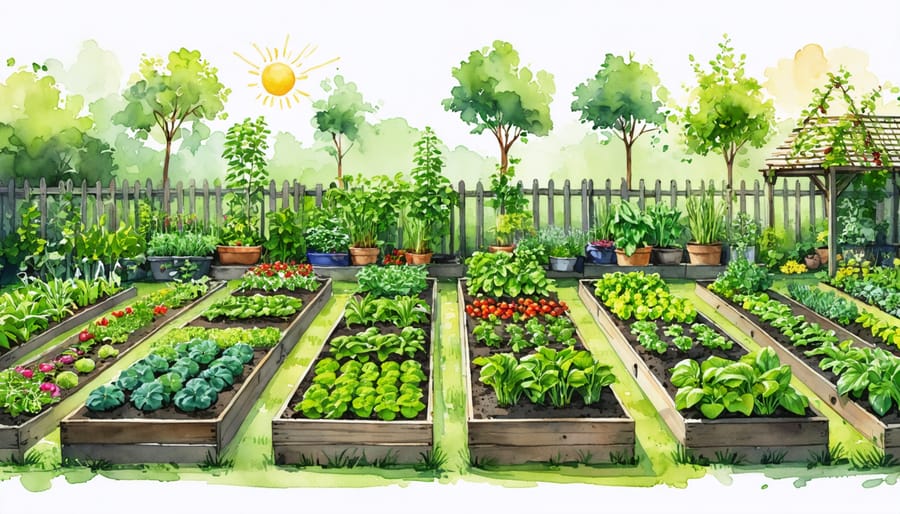Transform your Zone 5 vegetable garden into a thriving, four-season paradise by implementing proven gardening techniques tailored to your specific climate. Map your growing season from last frost date (typically mid-May) to first frost (early October), maximizing every productive week. Plant cold-hardy vegetables like peas and spinach in March under row covers, followed by heat-loving tomatoes and peppers after Mother’s Day. Structure your garden into 4×8 raised beds oriented north-south, incorporating companion planting groups that thrive in Zone 5’s temperature swings. This strategic approach, combined with succession planting every two weeks, ensures continuous harvests from spring through fall, even in challenging Midwestern conditions. Whether you’re working with a compact urban plot or sprawling country acreage, these time-tested Zone 5 planning principles consistently deliver abundant harvests while building healthy, resilient soil.
Understanding Your Zone 5 Growing Season
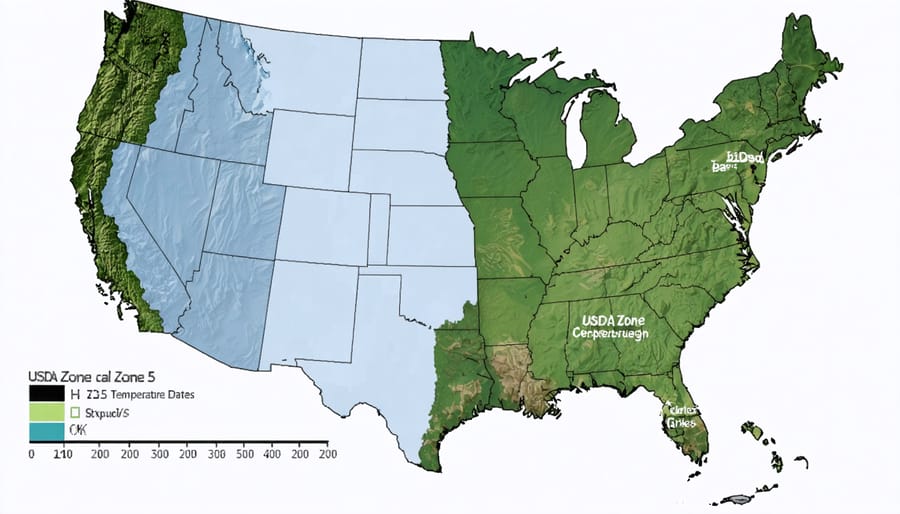
Key Dates for Zone 5 Gardeners
In Zone 5, successful vegetable gardening revolves around key seasonal dates and temperature markers. The last spring frost typically occurs between April 15th and May 15th, while the first fall frost arrives between September 15th and October 15th. This gives gardeners a growing season of approximately 150-170 days.
Soil temperature is crucial for seed germination. Wait until soil reaches 50°F (usually early April) to plant cold-hardy vegetables like peas, lettuce, and spinach. When soil warms to 60°F (mid-May), it’s time for main-season crops like tomatoes, peppers, and beans.
Spring transitions begin in March with indoor seed starting. By late April, you can start hardening off seedlings. Summer planting kicks into high gear in May, while fall crop planning should begin in July. Plant fall crops like carrots and brassicas by early August to ensure harvest before frost.
For season extension, consider using cold frames or row covers. These tools can help you start planting 2-3 weeks earlier in spring and extend your harvest 2-3 weeks later into fall, maximizing your Zone 5 growing season.
Microclimate Considerations
Understanding microclimates in your Zone 5 garden can significantly improve your growing success. Even within a single backyard, you’ll find areas with distinct temperature, moisture, and wind patterns that create unique growing conditions.
Start by observing your garden throughout the day. South-facing walls absorb heat and create warmer spots perfect for heat-loving vegetables like tomatoes and peppers. These areas can extend your growing season by providing protection from early frosts. Similarly, areas near fences or hedges offer wind protection, making them ideal for tall plants like pole beans and corn.
Low-lying areas tend to collect cold air and moisture, so avoid planting frost-sensitive crops there. Instead, use these spots for cold-hardy vegetables like kale and Brussels sprouts. Raised beds can help manage these challenging areas by improving drainage and soil temperature.
Don’t overlook the impact of hardscaping. Brick paths, stone walls, and even large rocks store heat during the day and release it at night, creating protective pockets for tender plants. By matching your vegetables to these natural microclimates, you can maximize your garden’s productivity and extend your growing season in Zone 5.
Spring Planning and Early Season Crops
Cold-Hardy Vegetables
Cold-hardy vegetables are the early champions of your Zone 5 garden, ready to brave the lingering chill of early spring. These resilient plants can be started as soon as the soil can be worked, typically in late March or early April. For best results, follow these expert growing tips when planning your early spring garden.
Start with peas, spinach, and lettuce as soon as soil temperatures reach 40°F (4°C). These crops thrive in cool weather and can withstand light frosts. About two weeks later, plant root vegetables like carrots, radishes, and beets. These underground treasures appreciate the cool, moist conditions of early spring.
Don’t forget about the brassica family! Cabbage, broccoli, and kale are excellent choices for early spring planting. Start these indoors 6-8 weeks before the last frost date, then transplant them outside when seedlings are strong. They’ll reward you with abundant harvests before summer’s heat arrives.
For a continuous harvest, plant successive rounds of these cold-hardy vegetables every two weeks throughout spring. This strategy ensures you’ll have fresh, homegrown produce from early spring through early summer, maximizing your garden’s productivity during the cooler months.
Remember to protect young plants with row covers or cold frames during unexpected frost events, and you’ll be well on your way to a successful early spring harvest.
Season Extension Techniques
In Zone 5, extending your growing season is crucial for maximizing your garden’s potential. Cold frames are like mini-greenhouses that protect your plants from frost while allowing sunlight to reach them. You can build a simple cold frame using old windows or clear plastic panels, placing them at an angle over your plants to create a protective environment.
Row covers are another excellent option for season extension. These lightweight fabric covers can be draped directly over your plants or supported by hoops. They not only protect against frost but also shield young plants from pests and harsh winds. For best results, secure the edges with soil or garden pins to prevent them from blowing away.
Clear plastic tunnels, also known as hoop houses, can extend your growing season by several weeks on both ends. Install them in early spring to warm the soil for earlier planting, and use them in fall to protect crops from early frosts. These structures are particularly effective for protecting cold-hardy vegetables like spinach, kale, and carrots.
Don’t forget about mulch as a season extension tool. A thick layer of straw or leaves around your plants helps regulate soil temperature and retain moisture. For extra protection during sudden cold snaps, keep a supply of old blankets or frost protection fabric ready to cover sensitive plants overnight.
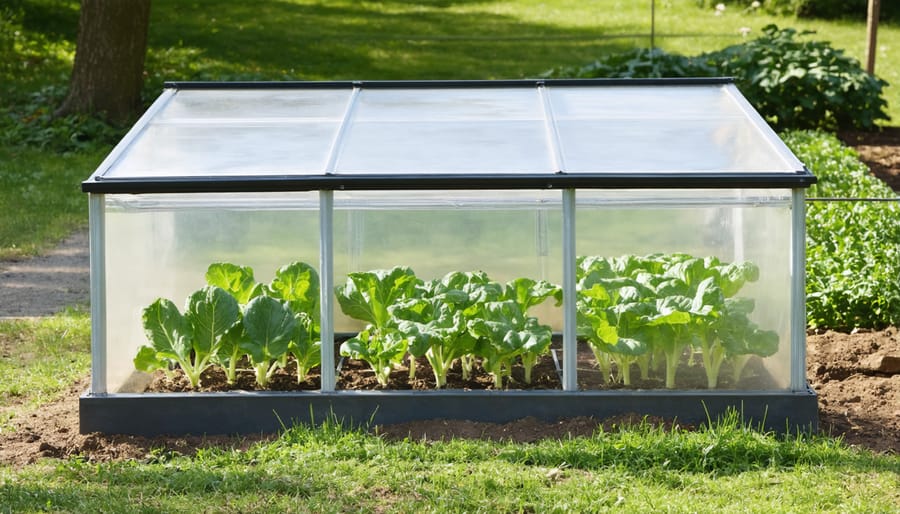
Summer Garden Layout and Succession Planting
Companion Planting Strategies
Companion planting is a time-tested strategy that can maximize your Zone 5 garden’s productivity while naturally deterring pests. Following proven garden layout principles, you’ll want to group plants that benefit each other while keeping antagonistic combinations apart.
Plant tomatoes alongside basil and marigolds to enhance flavor and repel unwanted insects. Carrots and onions make excellent neighbors, as onions help deter carrot flies. The “Three Sisters” method – combining corn, pole beans, and squash – works wonderfully in Zone 5 gardens, with corn providing support for beans while squash covers the ground to retain moisture.
Keep these spacing guidelines in mind:
– Plant tall crops like corn and pole beans on the north side to avoid shading shorter plants
– Space tomatoes 24-36 inches apart with basil planted 12 inches away
– Allow 18 inches between cabbage family plants with companion herbs like dill or thyme between them
– Edge your beds with marigolds, placing them 6-8 inches apart
Remember to rotate your plant families yearly to prevent soil depletion and disease buildup. This practice, combined with thoughtful companion planting, will help create a thriving, balanced garden ecosystem that naturally supports itself.
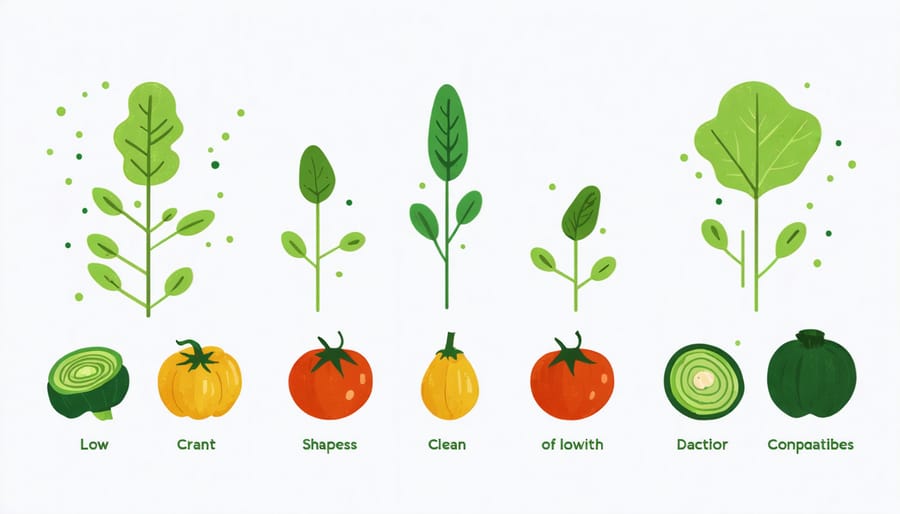
Succession Planting Calendar
To maximize your Zone 5 garden’s productivity, implementing a smart seasonal planting strategy is essential. Start your first plantings of cool-season crops like lettuce, peas, and radishes in early April, followed by a second round two weeks later. As May arrives, introduce your first wave of warm-season vegetables like tomatoes and peppers after the last frost date.
For continuous summer harvests, plant bush beans every two weeks from late May through early July. Succession plant salad greens every 10-14 days from April through August, switching to heat-tolerant varieties during peak summer. Quick-growing crops like radishes and turnips can be planted every 7-10 days.
Mid-June is perfect for starting your fall crops. Plant carrots and beets for autumn harvest, and start cole crops like broccoli and cabbage indoors for transplanting in July. By late July, focus on fast-maturing varieties that can handle light frost, such as spinach and Swiss chard.
Keep a garden journal to track planting dates and harvest times, adjusting your schedule based on what works best in your specific microclimate. Remember that weather patterns can affect timing, so stay flexible with your planting schedule while maintaining the overall rhythm of succession planting.
Fall Garden Planning
Second Season Crops
As temperatures begin to cool in late summer, Zone 5 gardeners have an excellent opportunity to plant a second round of crops for fall harvest. Cool-season vegetables like spinach, lettuce, kale, and Swiss chard thrive in autumn conditions and can often produce until the first hard frost. Plant these leafy greens in late July or early August for optimal results.
Root vegetables are particularly well-suited for fall gardens. Carrots, turnips, and radishes can be sown in August, while beets should go in the ground by mid-July. These crops often taste sweeter when harvested after light frosts, as the cold temperatures encourage sugar production.
Cole crops, including broccoli, cauliflower, and cabbage, make excellent second-season choices. Start these indoors in June or July, then transplant them into your garden in August. They’ll mature just as temperatures drop, producing crisp, flavorful heads.
For guaranteed success, consider fast-maturing varieties of peas and bush beans, which can go from seed to harvest in about 50-60 days. Just be sure to plant them early enough to harvest before your first frost date, typically in mid-October for Zone 5.
Winter Preparation
As winter approaches in Zone 5, protecting your garden soil and preparing for the next growing season becomes crucial. Start by removing all plant debris, including dead vegetation and fallen fruits, to prevent disease carryover. Once cleared, add a thick layer of compost to replenish nutrients and improve soil structure.
Consider planting cover crops like winter rye or clover in empty beds – these natural soil protectors prevent erosion and add valuable organic matter when tilled under in spring. For beds without cover crops, apply a 3-4 inch layer of mulch using straw, leaves, or pine needles to insulate the soil and protect beneficial microorganisms.
Take time to clean and sharpen your tools, storing them in a dry place to prevent rust. Remove and clean all plant supports, stakes, and trellises. This is also the perfect moment to review your garden journal, noting what worked well and planning improvements for next season.
If you have perennial vegetables like asparagus or rhubarb, mark their locations clearly and add extra mulch around their crowns for winter protection. Finally, ensure all water systems are drained and protected from freezing temperatures.
Sample Garden Plans
Small Space Plan (4×8 feet)
A 4×8 raised bed is perfect for maximizing your growing space in Zone 5, and with careful planning, you can grow an impressive variety of vegetables. Start by dividing your bed into one-foot squares, giving you 32 planting spaces to work with.
For optimal sun exposure, position taller plants like tomatoes and pole beans along the north side of the bed. Install a simple trellis system for vertical growing, which helps save precious ground space. Plant two indeterminate tomato plants, spacing them 2 feet apart, and train pole beans between them.
In the middle section, arrange medium-height plants like peppers, bush beans, and leafy greens. You can fit 4-6 pepper plants or 8-10 bush bean plants in this area. Create blocks of leaf lettuce, spinach, and Swiss chard, which can be succession planted throughout the season.
The front (south-facing) edge is ideal for low-growing crops like radishes, carrots, and compact herbs. These plants won’t shade others and are easy to harvest. Plant bunching onions or garlic along the edges to maximize space and naturally deter pests.
Consider companion planting relationships: basil near tomatoes, carrots next to onions, and marigolds scattered throughout to repel unwanted insects. With this layout, you can expect to harvest fresh vegetables from spring through fall in your Zone 5 garden.
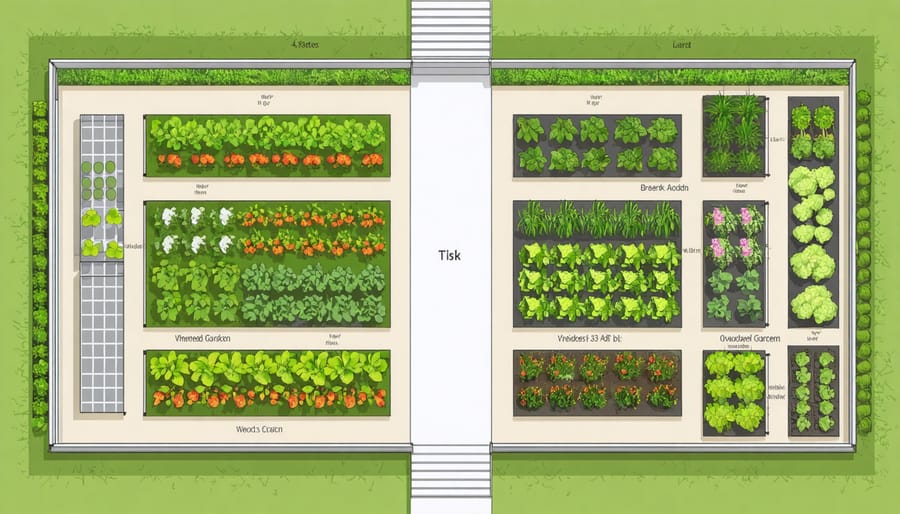
Full-Size Garden Plan (20×20 feet)
A 20×20-foot garden plot offers plenty of space for a diverse selection of vegetables while maintaining easy access and efficient crop rotation. Divide your garden into four main sections of 10×10 feet each, with 2-foot-wide paths between them for comfortable maintenance and harvesting.
In the first quadrant, plant your leafy greens and brassicas: lettuce, kale, cabbage, and broccoli. These cool-season crops can be started early in the Zone 5 growing season, typically in late March or early April.
The second quadrant is perfect for nightshades like tomatoes, peppers, and eggplants. These heat-loving plants should go into the ground after all danger of frost has passed, usually mid-May in Zone 5.
Reserve the third section for root vegetables and alliums: carrots, beets, onions, and garlic. Many of these can be succession planted throughout the season to ensure a continuous harvest.
The fourth quadrant accommodates vining crops such as cucumbers, squash, and beans. Consider installing a trellis system along the northern edge to maximize vertical growing space and prevent shading of other plants.
Each year, rotate your crops clockwise to the next quadrant. This practice helps prevent soil depletion and reduces pest and disease problems. Remember to add compost to each section before planting to maintain soil fertility throughout the growing season.
Planning a vegetable garden in Zone 5 may seem challenging at first, but with the right preparation and timing, you’ll be harvesting fresh, homegrown produce before you know it. Remember to start with a solid garden plan that accounts for your specific microclimate, available sunlight, and soil conditions. By selecting vegetables that thrive in Zone 5’s climate and following the recommended planting calendar, you’ll set yourself up for gardening success.
Don’t be afraid to start small and expand your garden gradually as you gain confidence and experience. Even a modest 4×8 foot raised bed can provide an abundance of fresh vegetables for your family. Focus on the crops you love to eat, and consider succession planting to extend your harvest throughout the growing season.
Keep in mind that gardening is both a science and an art – while following Zone 5 guidelines is important, you’ll develop your own techniques and preferences as you go along. Take notes about what works and what doesn’t in your garden, and adjust your plans accordingly for the next season.
Now is the perfect time to put your garden plans into action. Whether you’re a complete beginner or an experienced gardener looking to optimize your Zone 5 plot, the rewards of growing your own food are worth every minute of planning and preparation. Start gathering your supplies, preparing your soil, and getting ready to join the rewarding world of vegetable gardening!

